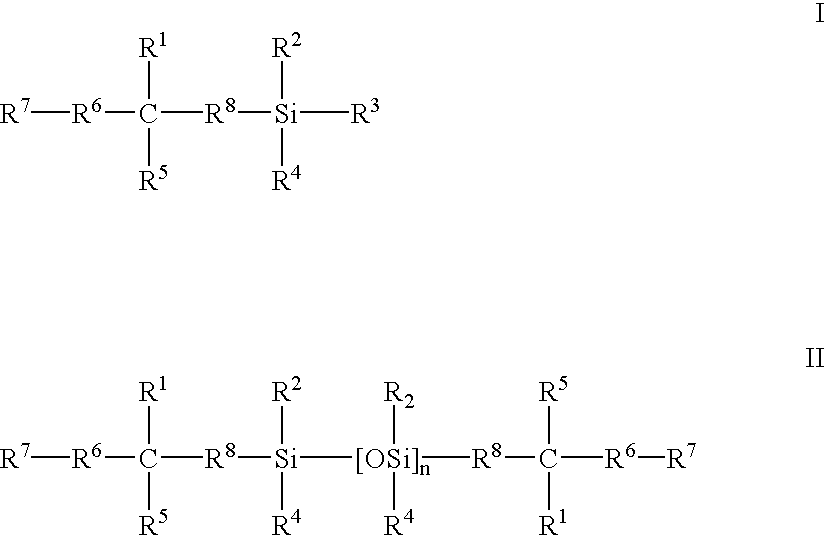Biomedical devices containing internal wetting agents
a technology of silicone hydrogel and biomedical devices, which is applied in the field of silicone hydrogel, can solve the problems of reduced visual acuity when using silicone hydrogel lenses, low incidence of surface deposits of uncoated silicone hydrogel lenses, and user discomfor
- Summary
- Abstract
- Description
- Claims
- Application Information
AI Technical Summary
Benefits of technology
Problems solved by technology
Method used
Image
Examples
examples
[0140]The following abbreviations are used in the examples below:
[0141]
SiGMA2-propenoic acid, 2-methyl-2-hydroxy-3-[3-[1,3,3,3-tetramethyl-1-[trimethylsilyl)oxy]disiloxanyl]propoxy]propyl esterDMAN,N-dimethylacrylamideHEMA2-hydroxyethyl methacrylatemPDMS800–1000 MW (Mn) monomethacryloxypropyl terminatedmono-n-butyl terminated polydimethylsiloxaneNorbloc2-(2′-hydroxy-5-methacrylyloxyethylphenyl)-2H-benzotriazoleCGI 18501:1 (wgt) blend of 1-hydroxycyclohexyl phenyl ketone andbis(2,6-dimethoxybenzoyl)-2,4-4-trimethylpentyl phosphineoxidePVPpoly(N-vinyl pyrrolidone) (K value 90)Blue HEMAthe reaction product of Reactive Blue 4 and HEMA, asdescribed in Example 4 of U.S. Pat. No. 5,944,853IPAisopropyl alcoholD3O3,7-dimethyl-3-octanolmPDMS-OHmono-(3-methacryloxy-2-hydroxypropyloxy)propylterminated, mono-butyl terminated polydimethylsiloxane(MW 1100)TEGDMAtetraethyleneglycol dimethacrylateTrEGDMAtriethyleneglycol dimethacrylateTRIS3-methacryloxypropyltris(trimethylsiloxy)silaneMPD3-methacryl...
examples 1 – 10
Examples 1–10
[0143]The reaction components and diluent (D30) listed in Table 1 were mixed together with stirring or rolling for at least about 3 hours at 23° C., until all components were dissolved. The reactive components are reported as weight percent of all reactive components and the diluent is weight percent of reaction mixture. The reaction mixture was placed into thermoplastic contact lens molds (made from Topas® copolymers of ethylene and norbornene obtained from Ticona Polymers), and irradiated using Philips TL 20 W / 03 T fluorescent bulbs at 45° C. for about 20 minutes N2. The molds were opened and lenses were extracted into a 50:50 (wt) solution of IPA and H2O, and soaked in IPA at ambient temperature for about 15 hours to remove residual diluent and monomers, placed into deionized H2O for about 30 minutes, then equilibrated in borate buffered saline for at least about 24 hours and autoclaved at 122° C. for 30 minutes. The properties of the resulting lenses are shown in Ta...
example 11
[0146]Lenses having the formulation of Example 1 were remade, without controlling cure intensity. The mechanical properties are reported in Table 2, below. These lenses were clinically evaluated using ACUVUE® 2 lenses as controls. The test lenses were worn in one eye and an ACUVUE® 2 lens was worn on the contralateral eye. The lenses were worn by 6 patients in a daily wear mode (nightly removal) for a period of one week. At one week the PLTF-NIBUT was 3.6 (±3.0) seconds compared to 5.8 (±2.5) seconds for ACUVUE® 2 lenses. The front surface deposition was graded none to slight for 50% of the test lenses and 100% for the control lenses. The movement was acceptable for both test and control lenses.
PUM
| Property | Measurement | Unit |
|---|---|---|
| weight % | aaaaa | aaaaa |
| weight % | aaaaa | aaaaa |
| weight % | aaaaa | aaaaa |
Abstract
Description
Claims
Application Information
 Login to View More
Login to View More - R&D
- Intellectual Property
- Life Sciences
- Materials
- Tech Scout
- Unparalleled Data Quality
- Higher Quality Content
- 60% Fewer Hallucinations
Browse by: Latest US Patents, China's latest patents, Technical Efficacy Thesaurus, Application Domain, Technology Topic, Popular Technical Reports.
© 2025 PatSnap. All rights reserved.Legal|Privacy policy|Modern Slavery Act Transparency Statement|Sitemap|About US| Contact US: help@patsnap.com



